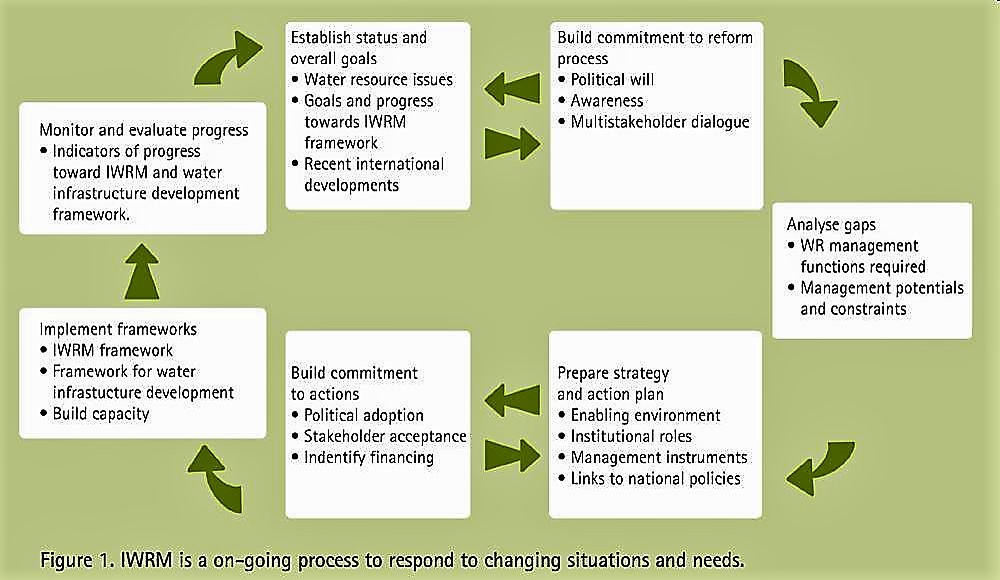Introduction
Water is a critical, but often overlooked element in sustainable development. If effective, long lasting solutions to water problems are to be found, a new water governance and management paradigm is required. Such a new paradigm is encapsulated in the Integrated Water Resources Management (IWRM) concept, which has been defined by GWP as “a process which promotes the coordinated development and management of water, land and related resources in order to maximise the resultant economic and social welfare in an equitable manner without compromising the sustainability of vital ecosystems.”
IWRM explicitly challenges conventional, fractional water development and management systems and places emphasis on integrated approaches with more coordinated decision making across sectors and scales. It recognises that exclusively top-down, supply led, technically based and sectoral approaches to water management are imposing unsustainable high economic, social and ecological costs on human societies and on the natural environment. Business as usual is neither environmentally sustainable, nor is it sustainable in financial and social terms. As a process of change which seeks to shift water development and management systems from their currently unsustainable forms, IWRM has no fixed beginnings and will probably never end. As the global economy and society are dynamic and the natural environment is also subject to change, IWRM systems will, therefore, need to be responsive to change and be capable of adapting to new economic, social and environmental conditions and to changing human values.
IWRM is not an end in itself but a means of achieving three key strategic objectives.
- efficiency to make water resources go as far as possible
- equity, in the allocation of water across different social and economic groups (see stakeholder identification)
- environmental sustainability, to protect the water resources base and associated ecosystems
It would be easy for a policy maker faced with the prospect of wholesale governance change to conclude that it is all too complex with too many difficult tradeoffs and choices to make. It may seem much easier and certainly politically safer to maintain current policies and practice and avoid confronting the vested interests who gain from the status quo. However, doing nothing is not an option; problems will simply get worse and more difficult to tackle.
IWRM should be viewed as a process rather a one-shot approach - one that is long-term and forward - moving but iterative rather than linear in nature. There is no such thing as a perfect IWRM system and the search for perfection can lead to action atrophy.

IWRM is based on four principles - the Dublin Principles
(adapted from GWP 2008 & Cap-Net 2010)
Principle 1: Fresh water is a finite and vulnerable resource, essential to sustain life, development and the environment
Water sustains life in all its forms and is required for many different purposes, functions and services; holistic management, therefore, has to involve consideration of the demands placed on the resources and the threats to it. Holistic management not only involves the management of natural systems; it also necessitates coordination between the range of human activities which create the demands for water, determine land uses and generate water borne waste products. Creating a water sensitive political economy requires coordinated policy making at all levels (from national ministries to local government or community – based institutions). There is also a need for mechanisms which ensure that economic sector decision makers take water costs and sustainability into account when making production and consumption choices. The development of such an institutional framework capable of integrating human systems – economic, social and political – represents a considerable challenge.
Principle 2: Water development and management should be based on a participatory approach, involving users, planners and policy-makers at all levels

Water is a subject in which everyone is a stakeholder. Real participation only takes place when stakeholders are part of the decision making process. This can occur directly when local communities come together to make water supply, management and use choices. Participation also occurs if democratically elected or otherwise accountable agencies or spokespersons can represent stakeholder groups. The type of participation will depend upon the spatial scale relevant to particular water management and investment decisions and upon the nature of the political economy in which such decisions take place.
Principle 3: Women play a central part in the provision, management and safeguarding of water
It is widely acknowledged that women play a key role in the collection and safeguarding of water for domestic and - in many cases - agricultural use, but they have a much less influential role than men in management, problem analysis and in the decision making process related to water resources.
Addressing gender as a cross-cutting goal requires that women's views, interests and needs shape the development agenda as much as men's, and that the development agenda support progress toward more equal relations between women and men. Gender needs should be part of the overall policy framework which can ensure that policies, program and projects address the differences in experiences and situations between and among women and men. Equal participation in social and political issues involves women's equal right to articulate their needs and interests, as well as their vision of society, and to shape the decisions that affect their lives. Their ability to do this can be strengthened through community organisations and institutions, and building participatory capacity.
Principle 4: Water has an economic value in all its competing uses and should be recognised as an economic good
Within this principle, it is vital to recognise first the basic right of all human beings to have access to clean water and sanitation at an affordable price. Past failure to recognise the economic value of water has led to wasteful and environmentally damaging uses of the resource.
Managing water as an economic good is an important way of achieving efficient and equitable use, and of encouraging conservation and protection of water resources. Value and charges are two different things. The value of water in alternative uses is important for the rational allocation of water as a scarce resource, whether by regulatory or economic means. Charging (or not charging) for water is applying an economic instrument to support disadvantaged groups, affect behaviour towards conservation and efficient water usage, provide incentives for demand management, ensure cost recovery and signal consumers willingness to pay for additional investments in water services.
Integrating three E’s
Integrated water resources management is based on the perception of water as an integral part of the ecosystem, a natural resource and a social and economic good, whose quantity and quality determine the nature of its utilisation.
The IWRM framework, as developed by the GWP, consists of three E's - economic efficiency, social equity and ecosystem sustainability.
- Economic efficiency in water use: Because of the increasing scarcity of water and financial resources, the finite and vulnerable nature of water as a resource, and the increasing demands upon it, water must be used with maximum possible efficiency
- Equity: The basic right for all people to have access to water of adequate quantity and quality for the sustenance of human well-being must be universally recognised
- Environmental and ecological sustainability: "The present use of the resource should be managed in a way that does not undermine the life-support system thereby compromising use by future generations of the same resource.” (GWP 2008)
For further information on IWRM, see also -----> http://www.gwptoolbox.org or http://www.cap-net.org
Catalyzing Change: A handbook for developing IWRM and water efficiency strategies
This handbook seeks to provide countries with the knowledge they need to act on the WSSD action target in the way that is most useful for them. Strategies should catalyze action, not retard it. Each country must decide the scope and timeline for change based on its goals and its resources. The important thing is to take the first steps.
GWP (2004): Catalyzing Change: A handbook for developing IWRM and water efficiency strategies. Stockholm: Global Water Partnership (GWP) URL [Visita: 16.05.2010]GWP Toolbox. Integrated Water Resources Management
The IWRM ToolBox is a free and open database with a library of case studies and references that can be used by anyone who is interested in implementing better approaches for the management of water or learning more about improving water management on a local, national, regional or global level.
GWP (2008): GWP Toolbox. Integrated Water Resources Management. URL [Visita: 16.05.2010]Looking up the pipe and down the drain!
This briefing note discusses the linkages between sanitation options and water resources and the ways in which concerns for both can be effectively integrated and managed.
SMITS, S. (2005): Looking up the pipe and down the drain! . Positioning sanitation within Integrated Water Resources Management. Leicestershire: WELL Resource Centre URL [Visita: 31.10.2010]Catalyzing Change: A handbook for developing IWRM and water efficiency strategies
This handbook seeks to provide countries with the knowledge they need to act on the WSSD action target in the way that is most useful for them. Strategies should catalyze action, not retard it. Each country must decide the scope and timeline for change based on its goals and its resources. The important thing is to take the first steps.
GWP (2004): Catalyzing Change: A handbook for developing IWRM and water efficiency strategies. Stockholm: Global Water Partnership (GWP) URL [Visita: 16.05.2010]Integrated Water Resources Management (IWRM)
The paper is divided in two main parts: The first part puts forward a strong case for applying IWRM globally and defines the IWRM concept and process. The second part provides additional advice and guidance on how IWRM could be implemented in different conditions.
GWP (2000): Integrated Water Resources Management (IWRM). (= TEC Background Papers , 4 ). Stockholm: Global Water PartnershipIntegrated Water Resources Management. Inforesources Focus
This issue of InfoResources Focus is dedicated entirely to IWRM. It explains the concept as such, discusses the challenges to sustainable water management, focuses on the implementation of IWRM at the policy level and also presents concrete IWRM experiences from the field. InfoResources is funded by the Swiss Agency for Development and Cooperation (SDC).
INFORESOURCES FOCUS (2003): Integrated Water Resources Management. Inforesources Focus. URL [Visita: 16.05.2010]Water Management, Water Security and Climate Change Adaptation: Early Impacts and Essential Responses
This paper argues that water resources management should be a focus for climate change adaptation and that IWRM is the most suitable approach to adaptive action. It outlines the likely social, economic and environmental impacts of climate change; the challenges climate change poses for water resources management; the actions needed to address those challenges – investments in infrastructure, institutions and information; and approaches to financing IWRM for adaptation.
SADOFF, C. MULLER, M. (2009): Water Management, Water Security and Climate Change Adaptation: Early Impacts and Essential Responses. Stockholm: Global Water Partnership Technical Committee (TEC) URL [Visita: 10.05.2010]Water 2015: Policy Principles and Strategic Guidelines for Integrated Water Resource Management – IWRM
This publication presents policy principles and strategic guidelines for integrated water resource management IWRM, developed by the Swiss Agency for Development and Cooperation.
SDC (2005): Water 2015: Policy Principles and Strategic Guidelines for Integrated Water Resource Management – IWRM. Bern: Swiss Agency for Development and Cooperation (SDC) URL [Visita: 26.08.2010]Water 2015: Principles and Guidelines
This publication presents a shortened version of the document “policy principles and strategic guidelines for integrated water resource management IWRM”, developed by the Swiss Agency for Development and Cooperation.
SDC (2005): Water 2015: Principles and Guidelines. Bern: Swiss Agency for Development and Cooperation (SDC) URL [Visita: 26.08.2010]Assessing Direct Economic Effects of Reallocating Irrigation Water to Alternative Uses
Irrigation water reallocations are playing an increasingly important role both in developed and developing countries. With growing urban and environmental water demands, rising cost for the development of new water supplies, and irrigated agriculture usually including the least economically valuable use of water, transfers of irrigation water to alternative uses are increasing. However, such reallocations are often controversial, and it is often questioned whether the benefits resulting from these transactions are large enough to outweigh the associated costs. The study, which is based on Economic and Sector Work (ESW) in the Water Anchor, reviews the experience with irrigation water transfers, including the involvement of the World Bank.
THE WORLD BANK (2011): Assessing Direct Economic Effects of Reallocating Irrigation Water to Alternative Uses. Concepts and an Application. URL [Visita: 17.10.2011]Status Report on IWRM and Water Efficiency Plans for CSD16
The Report aims to illustrate progress made on meeting the target to develop integrated water resources management and water efficiency plans by 2005, with support to developing countries, through actions at all levels agreed at the World Summit on Sustainable Development (WSSD) in Johannesburg in 2002, through the Johannesburg Plan of Implementation (JPoI). The Report is based on a survey covering 104 countries. The survey brings together the results of questionnaires by UN-DESA DSD and UNEP carried out in 2007.
UN Water (2008): Status Report on IWRM and Water Efficiency Plans for CSD16. . URL [Visita: 07.05.2013]Der Nexus Wasser-Energie-Nahrung
Vernetzte Versorgungsrisiken mit sektor- und grenzüberschreitenden Wechselwirkungen stellen für die Politik eine große Herausforderung dar. Ziel der vorliegenden Studie ist, die politische Dimension solcher Probleme zu erfassen und Bearbeitungsoptionen zu diskutieren. Denn häufig ist nicht die Verfügbarkeit einer Ressource oder der Mangel an Lösungsansätzen das zentrale Problem. Stattdessen fehlt es oft am politischen Willen, ein integriertes und langfristig nachhaltiges Management von Ressourcen und Risiken zielstrebig umzusetzen.
BEISHEIM, M (2013): Der Nexus Wasser-Energie-Nahrung. Wie mit vernetzten Versorgungsrisiken umgehen?. Berlin: Stiftung Wissenschaft und Politik (SWP) URL [Visita: 07.10.2013]Language: German
Water for the Environment: From Policy and Science to Implementation and Management
This book provides a holistic view of environmental water management, offering clear links across disciplines that allow water managers to face mounting challenges. The book highlights current challenges and potential solutions, helping define the future direction for environmental water management. In addition, it includes a significant review of current literature and state of knowledge, providing a one-stop resource for environmental water managers.
HORNE, A. et al. (2017): Water for the Environment: From Policy and Science to Implementation and Management. Academic Press URLIntroduction to IWRM. Presentation by D. Thalmeinerova, based on GWP Toolbox Resources
http://www.archive.cap-net.org/
Cap-Net has produced a brief and easy-to understand tutorial on IWRM. It is aimed at policy makers, water managers, trainers and educators who want a basic understanding of IWRM principles. The main “flow” of the tutorial is brief, but it allows you to branch out to environment, agriculture, water supply and sanitation and what IWRM can mean for these sectors.
GWP IWRM ToolBox
The website of GWP contains the toolbox as a web-based learning tool itself and additionally all publications by GWP. Topics of IWRM, Good Water Governance and many more IWRM related issues are discussed in a very comprehensive way. A very extensive collection of high-quality papers are available in English, French, Spanish and Russian. The site also contains a very extensive collection of case studies
www.unwaterlibrary.org/iwrm
This virtual library provides access to recent water and sanitation related publications produced by the United Nations system. This chapter shows the results on the theme IWRM.
Water, Land and People: Voices and insights from three continents
The initiative “Water, Land and People: Voices and insights from three continents“ promoted by the Swiss Agency for Development and Cooperation (SDC) aims at sharing and deepening the knowledge base of SDC and partners in order to improve the development strategies and policies with regard to Integrated Water Resource Management (IWRM) with emphasis on the aspect Water for Food.
Rivers Network
This open-source platform has dedicated itself to spread knowledge and awareness about the river basins of the world. It provides geographically specific information as a basis for improving sustainable management of rivers.
http://www.allianceforwaterstewardship.org
The Alliance for Water Stewardship (AWS) has launched in March 2013 the first International Water Stewardship Standard. The AWS Standard is designed to give companies and utilities a roadmap to follow towards sustainable water use, including engagement with stakeholders and others within their watershed. The Standard is designed to be applicable in all sectors and all regions.

